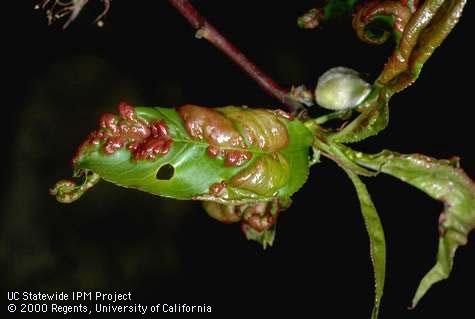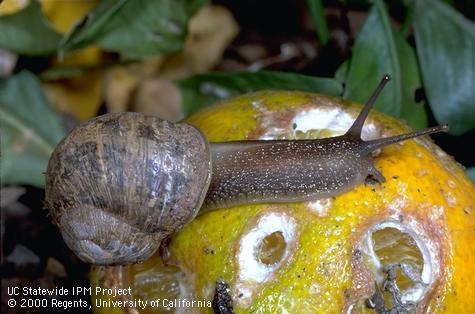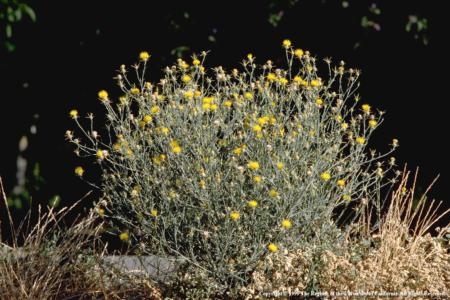
Posts Tagged: weed prevention
Fall Weed Management in Lawns and Landscapes
As the days get shorter and the temperatures begin to cool, now is the time to practice weed...
New Video on Using Mulch in the Garden
Using mulch in your garden or landscape helps conserve water and prevent weeds. This new UC IPM...
Top 10 Garden and Landscape Pests
Download the free booklet at the bottom of the page! 1. Ants Most people deal with ants...
Top 10 pests in gardens and landscapes and how to control them
Download the free booklet at the bottom of the page!
1. Ants

Most people deal with ants around their home at some point. Because most ants live outdoors, focus efforts on keeping ants from entering buildings by caulking entryways. Follow good sanitation practices to make your home less attractive to ants. Spraying ants inside the home will not prevent more ants from entering. Use baits to control the ant colony. Pesticide baits work by attracting worker ants who then take the poison back to the nest where the entire colony, including queens, can be killed. In the landscape, ants protect honeydew-producing pest insects from predators, so use sticky barriers or insecticide baits to keep ants out of trees and shrubs.
- Find out more at http://www.ipm.ucanr.edu/QT/antscard.html
2. Aphids

Aphids can curl leaves and produce sticky honeydew, but they rarely kill plants and you usually can wash them off with water. When aphid numbers get high, natural enemies such as lady beetles (lady bugs), lacewings, syrphid fly larvae, soldier beetles and others frequently feed on them, eliminating the need for pesticides. Protect these good bugs by avoiding the use of insecticides that can be toxic to a broad variety of insects. Ants protect aphids from these natural enemies, so keep ants away from your garden as well. When pesticides are necessary, use less toxic products such as insecticidal soaps and oils.
- Learn more about controlling aphids here: http://www.ipm.ucanr.edu/QT/aphidscard.html
3. Asian citrus psyllid and Huanglongbing disease

The Asian citrus psyllid (ACP) and the deadly bacterial disease it spreads, Huanglongbing (HLB), threaten citrus trees in backyards and on farms. There is no cure or effective control method for HLB disease. All types of citrus—including oranges, grapefruit, lemons, and mandarins—are affected as well as a few closely related ornamentals. ACP and HLB have already devastated the Florida citrus industry, and now that it is in the Western U.S. it is threatening the California citrus industry as well.
- See where the outbreaks are in California with our helpful Asian citrus psyllid website: http://ucanr.edu/sites/ACP/Distribution_of_ACP_in_California/
- Contact your agricultural commissioner's office, or call the California Department of Food and Agriculture (CDFA) Exotic Pest Hotline at 1-800-491-1899 to confirm a find. Learn more about ACP here: http://www.ipm.ucanr.edu/QT/asiancitruscard.html
4. Gophers

Gophers are small burrowing rodents that feed on roots of many types of plants. A single gopher can ruin a garden in a short time, and gopher gnawing can damage irrigation lines and sprinkler systems. In lawns, their mounds are unsightly and interfere with mowing. Early detection is critical to prevent damage. Use both traps and underground fencing to manage gopher problems. Toxic baits are available but can pose threats to wildlife, pets, and children, especially in backyard situations.
- Learn more about protecting your garden and landscape from gophers here: http://www.ipm.ucanr.edu/QT/gopherscard.html
5. Leaf-feeding caterpillars

Caterpillars, which are the larvae of butterflies and moths, damage plants by chewing on leaves, flowers, shoots, and fruit. Caterpillars in fruit or wood can be difficult to manage because they are hidden most of their life and can cause serious damage even when numbers are low. However, many plants, especially perennials, can tolerate substantial leaf damage, so a few leaf-feeding caterpillars often aren't a concern. Handpicking and beneficial predators and parasites often provide sufficient control. Look for feeding holes, excrement, webbed or rolled leaves, caterpillars, eggs, and good bugs.
- Learn more here:http://www.ipm.ucanr.edu/QT/lfcaterpillarscard.html
6. Peach leaf curl

Peach leaf curl is a fungal disease that affects only peach and nectarine trees. Distorted, reddened foliage in the spring is a distinctive symptom. New leaves and shoots thicken and pucker and later may die and fall off. An infection that continues untreated for several years can lead to a tree's decline. To prevent peach leaf curl, treat peach and nectarine trees with a copper fungicide every year after leaves fall. After symptoms appear in the spring, any treatment will not be effective. When planting new trees, consider buying peach tree varieties that are resistant to the disease.
- To learn more about preventing peach leaf curl click here: http://www.ipm.ucanr.edu/QT/peachleafcurlcard.html
7. Rats

Rats eat and contaminate food, garden produce, and fruit, and transmit diseases to humans and pets. Manage rats by removing food and shelter, eliminating entryways into buildings, and trapping. Snap traps are the safest, most effective, and most economical way to trap rats. For Norway rats, place traps close to walls, behind objects, in dark corners, and in places where you have found rat droppings. For roof rats, place traps in off-the-ground locations such as ledges, shelves, branches, fences, pipes, or overhead beams. Ensure traps are out of reach of children and pets.
- Learn more about preventing and controlling rats here: http://www.ipm.ucanr.edu/QT/ratscard.html
8. Scales

Scale insects suck plant juices and are pests of many trees and shrubs. Infestations can cause yellowing or premature dropping of leaves, sticky honeydew, and blackish sooty mold. Plant parts can distort or die back, depending on the species and abundance of scales. Most plants tolerate low to moderate numbers of scales. Provide plants with proper cultural care, especially irrigation. Encourage scale predators such as lady beetles or lacewings and look for parasite emergence holes in scale covers. Use sticky barriers or insecticide baits to selectively control scale-tending ants. Consider replacing problem-prone plants because most scales are highly specific to certain plants.
- Learn more about controlling scale populations here: http://www.ipm.ucanr.edu/QT/scalescard.html
9. Snails and slugs

These slimy mollusks emerge from hiding at night and chew holes in leaves and flowers of many succulent garden plants and fruit. Management requires a vigilant and integrated approach that includes eliminating moisture and hiding spots, trapping, setting up barriers, and handpicking. Regularly remove snails from shelters you can't eliminate such as low ledges on fences, undersides of decks, and meter boxes. Place traps in your garden and dispose of trapped snails and slugs daily. Reduce moist surfaces by switching to drip irrigation or watering in the morning rather than later in the day. Consider snail-proof plants such as impatiens, geraniums, begonias, lantana, nasturtiums, and many plants with stiff leaves and highly scented foliage such as sage, rosemary, and lavender.
- Learn more about controlling snails and slugs with and without pesticides in your garden here: http://www.ipm.ucanr.edu/QT/snailsslugscard.html
10. Weeds in landscapes

Prevent weed invasions in new beds with good site preparation. Keep weeds out with an integrated program that includes competitive plants, mulches, and hand removal. Be particularly vigilant about removing aggressive perennial weeds. You rarely should need herbicides in established landscape plantings. Mulches prevent weed seed germination by blocking sunlight. Remove small weeds by hand before they flower and set seed. Use shallow cultivation or hoeing to remove annual weeds from ornamental plantings. Only use herbicides for special-problem situations before establishing new plantings or for difficult-to-control perennial weeds.
- Learn more about controlling weeds in your landscape here: http://www.ipm.ucanr.edu/QT/landscapeweedscard.html
To see all of the University of California's Statewide Integrated Pest Management Program's information on home, garden, and landscape pests, visit http://www.ipm.ucanr.edu/PMG/menu.homegarden.html
For other short pest “Quick Tips” like the ten above, see http://www.ipm.ucanr.edu/QT/
To read even more in-depth, peer-reviewed information on many other common home and landscape pests in California, see the Pest Notes series at http://www.ipm.ucanr.edu/PMG/PESTNOTES/index.html
Download your free UC IPM Quick Tips Booklet of the Top Ten Pests in Gardens and Landscapes and How to Control Them with the link below!
Collaboration may be an effective way to fund wildland weed control
Many funding sources for weed eradication have been reduced or completely eliminated. According to the California Assembly Budget Committee’s annual Preliminary Review of the Governor’s Proposed 2012-13 State Budget, the California Department of Food and Agriculture will absorb a permanent budget reduction of $12 million in program cuts, in addition to a $19 million budget reduction in 2011-12. Funding for weed management areas (WMAs) has been reduced to the point that many WMAs have become inactive or are being managed voluntarily as an adjunct to other duties.

Enter the collaborative grant-funded project. Agencies are looking for applications that demonstrate community support from a diverse range of stakeholders. For example, the Sierra Nevada Conservancy (SNC) is currently reviewing proposals received in response to their Healthy Forests initiative. Proposition 84 — The Safe Drinking Water, Water Quality and Supply, Flood Control, River and Coastal Protection Bond Act of 2006 — will fund approved projects. Five million dollars is available this year for healthy forest projects; next year an equal amount will be available for rangeland projects.
Two weed control projects created by UC Cooperative Extension Central Sierra received SNC invitations to submit complete grant applications. One project is a collaboration between UCCE, the U.S. Forest Service, and Yosemite National Park; another works in partnership with Cal-IPC.
As an example of the collaborative partnerships being sought by funding agencies, the National Fish and Wildlife Foundation is offering the ‘Pulling Together Initiative’ which “seeks proposals that will help control invasive plant species, mostly through the work of public/private partnerships such as Cooperative Weed Management Areas.” Successful projects must “have a project Steering Committee composed of local cooperators who are committed to working together to manage invasive and noxious plants across their jurisdictional boundaries.”
Clearly, in light of decreased federal and state funding, a strategic direction for weed-control projects will be to leverage resources, working together to do what no one agency can accomplish alone.
Two additional collaborative projects, created by Wendy West of UCCE Central Sierra, are highlighted here:
- A Weed-Free Forage List providing California resources for weed-free feed and erosion control materials will soon be posted on Cal-IPC’s website. The site will also contain explanatory information about weed-free certification, along with links to inspection procedures and noxious weed lists.
- Workshops designed to help prevent the spread of weeds during construction, aggregate production and maintenance activities are being offered throughout the state. The workshop is hosted and sponsored by U.S. Forest Service, National Park Service, California Department of Food and Agriculture, University of California and University of Nevada Cooperative Extension, and the California Invasive Plant Council.
A Fresno County workshop was held in January and a sold-out workshop is scheduled for March in Los Angeles County. If you are located in the central California region that includes Amador, Calaveras, El Dorado, Madera, Mariposa, San Joaquin, Stanislaus or Tuolumne counties, please consider attending the next workshop, scheduled for April 9 in Sonora. The final workshop will be held in Truckee on May 2. Register for the workshops here.
Prevention Workshop 2012 flier
Workshop Schedule.Agenda
